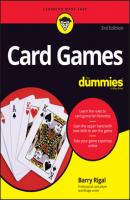Card Games For Dummies. Barry Rigal
Чтение книги онлайн.

Читать онлайн книгу Card Games For Dummies - Barry Rigal страница 9
Название: Card Games For Dummies
Автор: Barry Rigal
Издательство: John Wiley & Sons Limited
Жанр: Сделай Сам
isbn: 9781119880448
isbn:
The suits: I represent each of the four suits in a standard deck of cards with spade ♠, heart ♥, club ♣, and diamond ♦ symbols.
The card values: I use the following abbreviations to refer to specific card values: ace (A), king (K), queen (Q), jack (J), 10, 9, 8, 7, 6, 5, 4, 3, and 2.
When I refer to a specific card in the text, you see ♥K and ♠7 rather than “the king of hearts” or “the 7 of spades.”
I show you entire hands of cards in figures to help you see what a set of cards looks like when you’re actually holding it in your hand.
During the printing of this book, some Web addresses may have broken across two lines of text. If you come across such a situation, rest assured that we haven’t put in any extra characters (such as hyphens) to indicate the break. So, when using one of these Web addresses, type in exactly what you see in this book, pretending as though the line break doesn’t exist.
What You’re Not to Read
For the most part, I’ve tried to avoid using more technical jargon than is absolutely necessary. However, the book does include some sidebars that give you historical perspective on how certain games were created or about where you can go online for additional information about specific games. These are asides and not critical to the text. You can spot them easily enough — the text is on a shaded background.
Foolish Assumptions
I’m not going to assume that the average reader will have all that much technical knowledge. Frequently, the most challenging bit of mathematics you have to perform is to count up to 1! The book is aimed at serving as an introduction to many card games. If you get hooked after reading it, you can access many other Dummies publications that can provide advanced knowledge of the games. For example, if you want to focus on Bridge, I recommend Bridge For Dummies by Eddie Kantar (Wiley). I also urge you Poker fiends out there to check out Poker For Dummies by Richard D. Harroch and Lou Krieger (Wiley) and Winning at Internet Poker For Dummies by Mark Harlan and Chris Derossi (Wiley).
Icons Used in This Book
In each chapter, I place icons in the margin to emphasize the following types of information:
Beyond This Book
In addition to the material in the print or ebook you’re reading right now, this product comes with some goodies on the Web that you can access anywhere. Simply go to www.dummies.com and type in “Card Games For Dummies, 3rd Edition Cheat Sheet” in the Search box. You’ll find handy tips and tricks on picking the best games, card game do’s and don’ts, and more!
Where to Go from Here
Each game in this book is a self-contained chapter. If you want information on a particular game, consult the appropriate chapter and discover everything you need to know in order to get started.
Along with the Table of Contents at the front of the book, the index at the back of the book can help you locate the game you want to play without too many diversions. Having said that, one of the more interesting ways to experience this book may be to open it at random and discover a game that you’ve never heard of before.
Part 1
Discovering Card Games
IN THIS PART …
After I explain some of the basics of cards (along with some tidbits about the history of cards and the etiquette of card games), I introduce a diverse range of games for you to deal out. If you don’t have anyone to play cards with, don’t worry. I provide an entire chapter of Solitaire card games. And if you’re a beginning card player, teaching children to play cards, or just a kid at heart, check out the chapter on popular children’s games, including War and Go Fish. Enjoy!
Chapter 1
Card Game Basics
IN THIS CHAPTER
I’m sure that if you’ve ever played cards at all, you don’t need me to explain what fun 52 pieces of pasteboard can be. But just in case, here goes …
Because you don’t know what the other players have in their hands in almost every card game, playing cards combines the opportunity for strategy, bluffing, memory, and cunning. At the same time, you don’t have to play cards all that well in order to enjoy yourself. Cards allow you to make friends with the people you play with and against. A deck of cards opens up a pastime where the ability to communicate is often of paramount importance, and you get to meet new faces and talk to them without having to make the effort to do so.
If you want to take the plunge and start playing cards, you encounter a bewildering range of options to choose from. Cards have been played in Europe for the last 800 years (see the sidebar “Card Games Through the Ages” for more details), and as a result, you have plenty of new games to test out and new СКАЧАТЬ